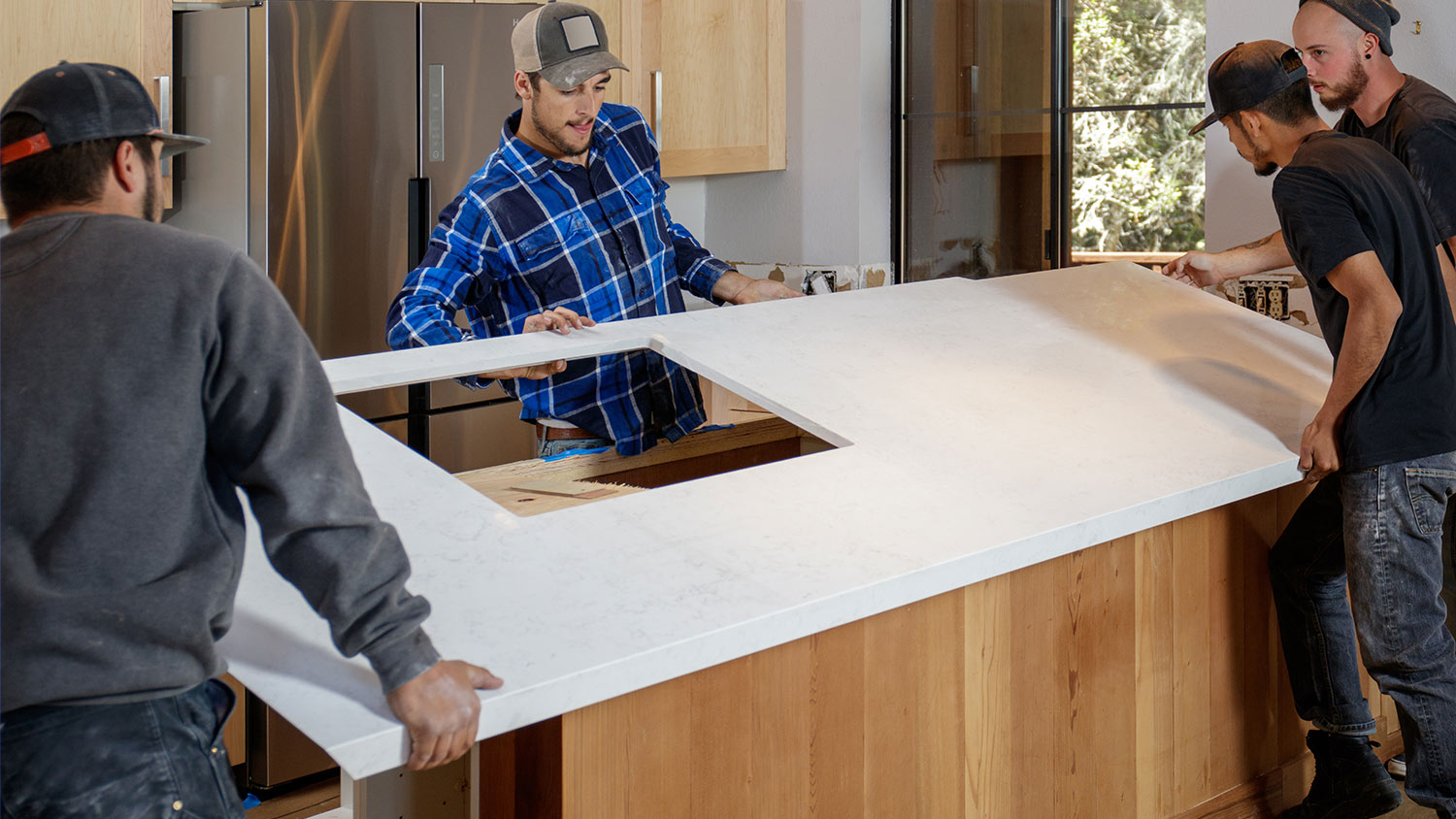
Discover cabinet installation cost estimates, including average prices, key cost factors, and tips to save on your new kitchen or bathroom cabinets.
You can bid farewell to '90s linoleum or '70s formica yourself


Remodeling your kitchen can be an expensive and lengthy process. From soup to nuts, a full kitchen remodel clocks in at around $30,000 and is a large undertaking. Removing your own countertops can save you some cash, as long as you feel confident that you know what you’re doing with some standard DIY tools and have a free afternoon on your hands.
Laminate or solid surface countertops will be the easiest to remove because they are the lightest materials. If you’re removing quartz, solid granite, or stone counters, you may want to consider hiring a local countertop installer for the job. Here are steps for how to remove a countertop safely.

Before you begin your countertop removal, you’ll need a clear surface. Relocate any dishes, cutting boards, appliances, or anything else on the counter’s surface to another area. Once you’ve cleared your countertops, remove the drawers and items in the cabinets underneath your counters. That’ll prevent dust and debris from getting into your stuff, making clean-up easier.
You’ll need to shut off the three main utility sources before you begin your countertop removal:
Turn off the main electrical power supply to your outlets (usually at the fuse box).
Shut off the gas line (use your wrench or the valve knob, if needed).
Take your bucket and place it underneath the sink to catch any stray water, then turn off the supply line valves, disconnect your water lines, garbage disposal, and drain lines.
Be sure you have someone else nearby to help you with this step—sinks can be heavier than you might imagine—especially if you have a sink made of a heavier material such as cast iron. There are two basic types of sinks: drop-in and undermount.
Drop-ink sink: Use your putty knife to slip under the rim and chip away at the adhesive holding the sink in place. You may need to use the caulk softener to remove the adhesive, so keep that handy. Once you’ve detached the adhesive, you can lift the sink out.
Undermount sink: Unscrew and remove the brackets under the counter that hold it in place. Undermount sinks also use caulk to seal them into place, so use your putty knife and caulk softener to remove this sealant. Once you’ve unsealed the sink, lift it out.
“For demolition, your reciprocating saw is your best friend,” says Bob Tschudi, Expert Review Board Member and Raleigh, N.C.-based general contractor. “Be sure to have all-purpose blades as well as metal-cutting blades. For cabinet removal, we often have to cut the screws that secure the cabinets to the walls.”
Now you’re ready to start removing the countertops. Countertops are usually sealed onto the base with adhesive. Using your caulk softener, spray around the edges of the counter and backsplash, then let the softener sit for one hour.
After the hour is up, use your putty knife or box cutter to pry the counter away from the wall or backsplash, as well as the base. Move carefully around the edges of your countertop, loosening as you go until it is loose enough to lift a bit. You may have to use a hammer with your putty knife to wedge between the backsplash and the wall—the adhesive softener should help with this. If you need to use a hammer, be careful not to damage your walls as you separate the countertop.
In addition to being held in place with adhesive, your countertops might also be screwed in underneath. You’ll likely have to get in the cabinet and look up to see where the screws are. Once you’ve located them, use a screwdriver or a drill with a screwdriver bit to remove the screws.
After removing the screws, you should be able to lift your countertops off of the base cabinets. This is another step where a second person will come in handy since countertops come off in larger pieces and can be heavy and unwieldy. If you’re replacing your countertops with laminate or a solid surface, you can leave the plywood sub-surface in place. Otherwise, you can remove this as well by lifting it off.
Many municipalities won’t take construction materials with regular trash, so you’ll need to make special arrangements for your old countertops. Weekly dumpster rentals may be worthwhile if you’re doing a larger renovation project and need more flexibility. In some cases, you can make special arrangements with the city to pick up bulkier items.
If you’d rather not do all the heavy lifting involved in removing countertops—or the city won’t accept such heavy trash—turn to a local junk removal company instead. These pros will do all the work of removing and transporting your waste, including but not limited to countertops. Junk removal costs range from $60 and $600 depending on the size and amount of objects you need to get rid of, but you can expect to pay an average of roughly $240 for everything involved.
If you have tile countertops, each tile will need to be removed individually with a flat chisel before lifting out the under layer. Removing the tiles one by one is fairly labor-intensive, but it will make the counter much lighter than if you leave them on and install over them.
Granite and stone countertops are best left to the professionals for removal. They’re extremely heavy and come in large pieces, so call in a countertop installer near you for a removal quote.
“If you are removing a granite, marble, quartz, or other high-end countertop, consider selling it, with the condition that the buyer removes it,” says Tschudi. “Not only does this save on labor, but you can often make enough money to buy the crew lunch for the day.”
Countertops and cabinets are two of the most commonly updated features in kitchen remodels. Responses from 206,600 Angi customers show that 23.9% of homeowners requested countertops be moved or installed, while 22.8% requested the same for cabinets. These figures highlight how central these elements are to both the look and functionality of a remodeled kitchen.
From average costs to expert advice, get all the answers you need to get your job done.

Discover cabinet installation cost estimates, including average prices, key cost factors, and tips to save on your new kitchen or bathroom cabinets.

Kitchen islands are multipurpose workhorses in your kitchen. When looking to add one to your home, you should consider its size, materials, and its primary use in your home. Learn about the price of kitchen islands and their different features.

Countertop repair costs may be the deciding factor between replacing or repairing your counter. Let’s break down the cost to repair, resurface, or relaminate.

Looking for a unique countertop material that’s low maintenance, durable, and cost-effective? Check out the pros and cons of porcelain countertops.

A mitered edge countertop can add a subtle design statement to your kitchen or bathroom. Here’s everything to know, including the pros, cons, and costs.

It's important to get the dimensions right if you're installing new kitchen countertops. Read on to find out more about the standard depth of countertops.